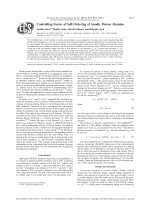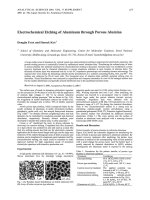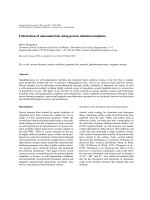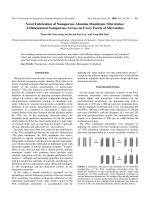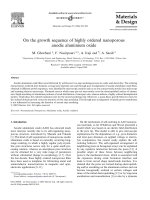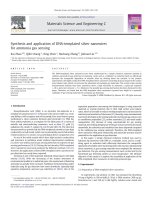- Trang chủ >>
- Khoa Học Tự Nhiên >>
- Vật lý
templated self-assembly of nanoporous alumina
Bạn đang xem bản rút gọn của tài liệu. Xem và tải ngay bản đầy đủ của tài liệu tại đây (33.24 MB, 324 trang )
Templated Self-Assembly
of
Nanoporous Alumina:
Pore Formation and Ordering Mechanisms,
Methodologies, and Applications
by
Ramkumar Krishnan
M.S., Chemical Engineering, University
of
Florida,
USA
(1999)
B.Tech., Chemical and Electrochemical Engineering, CECRI, India (1996)
Submitted to the Department
of
Materials Science and Engineering
in Partial Fulfillment
of
the Requirements for the Degree
of
Doctor
of
Philosophy
at the
MASSACHUSETTS INSTITUTE OF TECHNOLOGY
September 2005
© Massachusetts Institute
of
Technology 2005.
All
rights reserved.
Author ' .
Department
of
Materials Science
and
Engineering
August 18, 2005
Certified
b'y
~
,;-;-; ;.H
••
•
••••••••••••••
l
':"':':":"
.
,
Carl V. Thompson
Stavros Salapatas Professor
of
Materials Science and Engineering
Thesis Advisor
Accepted by
(:;;7=:":'
•
:.:.:
:.:.=.o
.,::.:
::!!:.:,.::.:
:; ;
~-er-b-ra":n:::d
~ccxi::iiiieliirr
~~~~~~t\ P.
Simmons Professor
of
Materials Science and Engineering
MASSACHUSETTS INS
OF TECHNOLOGY
Chair, Departmental Committee on Graduate Students
[
SE~
29
2005
LIBRARIES
of
Nanoporous
Alumina: Pore Formation and
()rdering Mechanisms, Methodologies, and Applications
by
Ramkumar Krishnan
Submitted to the Department
of
Materials Science and Engineering
on August
18,
2005 in Partial Fulfillment
of
the
Requirements for the Degree
of
Doctor
of
Philosophy
Abstract
Porous anodic aluminum oxide (AAO), also known as porous alumina,
is
a self-ordered
nanostructured material well-suited for use in electronic, magnetic, optical and biological
applications due to its small pore size (4-200nm) and spacing (10-500nm). Under slightly
acidic conditions, both oxidation and dissolution
of
aluminum leads to the formation
of
pores. AAO pores form a self-assembled honey-comb structure with short range order
over certain ranges
of
anodic potential and pH. In this work, three key results related to
porous AAO science and technology are presented.
First, a new theory based on strain-induced instability has been developed from the
analysis
of
results obtained from kinetic studies and stress measurements to explain the
formation
of
AAO pores. Experiments show that excess vacancies
of
aluminum, created
by the dissolution process, generate a large tensile stress and an associated strain energy,
which destabilizes the initially flat
AU
AAO interface and leads to pore formation. Other
factors affecting stability
of
the
All
AAO interface and the self-assembly process are also
presented.
Second, templated self-assembly (TSA)
of
AAO pores, ordered over wafer-scale areas
and with controlled spacing and symmetry, have been achieved by pre-patterning the
substrate using interference lithography. TSA
of
AAO pores led to control
of
pore
spacing and order symmetry in ranges not achievable without templating. Independent
control
of
pore spacing and diameter were successfully demonstrated, allowing formation
of
novel 3-D nanostructures such as nanofunnels, fabricated using periodic variations in
the anions and/or electrolyte pH. Using the TSA approach, AAO with ordered pores
<35nm in diameter and aspect ratios >50:1 were fabricated on Si substrates. A I-D array
of
ordered pores, either in or out
of
plane with the substrate, was fabricated by confining
the growth
of
AAO pores using silicon oxide masks patterned by lithography techniques.
Finally, AAO templates were used to fabricate ordered nanostructures including
carbon nanotubes, magnetic nanotubes and antidots, and metallic nanowires and
nanoparticles, all
of
which display properties very different from their bulk counterparts.
These results, and other proposed methodologies, provide new techniques for controlled
in-plane and out-of-plane growth and organization
of
nanotubes and nanowires on
Si
substrates.
Thesis Supervisor: Carl
V.
Thompson
Title: Stavros Salapatas Professor
of
Materials Science and Engineering
3
4
Acknowledgements
This thesis
is
a culmination
of
not only my passion to understand scientific
phenonlena but also
as
a result
of
interactions with like-minded researchers within and
outside the MIT community. MIT and DMSE have rewarded me with a solid foundation
in materials science through academic classes, research programs and collaborations. At
MIT, some
of
my acquaintances have become best friends and family, including the
person whom I love the most. Various programs have introduced me to a multitude
of
topics from music to social work and I wish to thank the MIT community at large - MIT
truly
is
a place
of
learning. Several individuals have directly contributed to the success
of
my thesis both personally and professionally and I wish to express my gratitude
to
them.
I would like to first thank my thesis advisor, Professor Carl Thompson, for his
guidance and support. He provided me with the intellectual freedom to work on several
stimulating research projects. His acuteness for understanding experimental results and
his intuitive and methodical approach to solving scientific challenges inspire
me.
I am
grateful to my committee members, Prof. Caroline Ross and Prof. Donald Sadoway, for
their valuable suggestions and for reviewing my dissertation.
It
has also been a rewarding
experience working with Prof. Ross and her group on a variety
of
research topics.
I appreciate the contributions
of
all my collaborators, especially
Dr.
Kornelius
Nielsch, who shared his experimental knowledge and scientific equipments. Our joint
research efforts led to some
of
the key results presented in this thesis. I would like to
acknowledge Prof. Henry Smith,
Dr.
Fernando Castano, Robert Barsotti
of
MIT, Prof.
Wee Choi and Hung Nguyen
of
NUS-Singapore for sharing their expertise and funding
agencies:. MARCO and SMA for the financial support that made this work possible.
5
I am thankful to the current and past members
of
CVT group - in particular,
Rajappa Tadepalli, Cody Friesen, Jihun Oh, Amanda Giermann, Byron Hsu, Jinsuk Kim,
Reiner Monig, Robert Bernstein, Zung Choi, Andrew Takahashi, and Steve Seel for their
helping hands, scientific and non-scientific conversations, and for providing a friendly
work atmosphere. I am grateful to the staff
of
MTL, NSL and CMSE facilities for their
assistance with experiments. Kurt Broderick especially has helped me with many
experimental hurdles with a big smile, even working late hours.
I am indebted to two
of
my best friends, Nagarajan Nandakumar and Sanjay
Pahuja who supported me during the best and worst times
of
my life. Special thanks also
go to my friends, Sajan Saini, Manish Deopura, Kurt Broderick, Chaitanya Ullal, and
Rajappa Tadepalli with whom I have shared many laughs and memorable hours at MIT.
I wish to express my appreciation to my father, Krishnan, and my brother,
Chandramouli, for their moral support and encouragement. My achievements are a result
of
my father's hard work to help support my ambitions. I have received unconditional
support from my in-laws, Ramesh and Pragna Shah. My mother-in-law has always been
there personally to help in times
of
need.
Last, but not the least, I am blessed with the presence
of
two women in my life to
whom I dedicate this thesis. My mother, Savithri, has always wished the best for me and
has sacrificed a lot
to
support my dreams. Words cannot explain the constant love,
support and understanding I receive each day from my dearest wife, Rajul. I am touched
by her sacrifice during the past year when I retreated to long hours and weekends
of
experiments and thesis writing. She has made even this challenging time memorable. I
wouldnot be whatI am withoutyou.
6
Contents
1.
Introduction
35
1.1
Self-Assembly
35
1.2
Templated Self-Assembly 37
1.3
Porous Alumina Self-Assembly
38
1.4
Objective 39
1.5
Thesis Outline 40
2.
Anodic oxidation
of
aluminum: Background and previous
work
43
2.1
Introduction
43
2.2 Barrier and porous anodic oxides
of
aluminum 44
2.3 Electrochemistry at the metal-oxide and oxide-solution interfaces 46
2.4
G"eneral
structural features and material properties
of
anodic alumina
48
2.4.1 Inner and outer oxide
48
2.4.2 Oxide composition
49
2.4.3 Transport numbers 50
2.4.4 Dielectric breakdown
51
2.5 Theories
of
oxidation kinetics and ion transport
51
2.6 Potential and current transients
53
2.7 Influence
of
electrochemical conditions
55
2.7.1 Effect
of
applied voltage (pH, T fixed)
56
2.7.2 Effect
of
applied current density (pH, T fixed) 57
2.7.3 Effect
of
pH
57
2.7.4 Effect
of
temperature
59
2.8 Stress generation during anodic oxidation
of
aluminum
62
2
1.2
Introduction
62
3
1.3
Stress due to volume change and Pilling-bedworth ratio
63
4
1.4 Stress due
to
vacancy incorporation/annihilation
63
5.1.5 Stress due to the applied electric field (electrostriction) 66
6.1.6 Stress due to anionic impurities and composition variations 67
2.9 Pore formation and growth mechanisms
67
2.10 Pore ordering mechanisms
76
2.11
Experimental techniques for fabrication
of
porous alumina with
short-range order
78
7
2.12 Experimental techniques for fabrication
of
porous alumina with
long-range order
81
2.12.1 Nano-imprint lithography
81
2.12.2 Electron-beam and lon-beam lithography
84
2.12.3 Scanning probe lithography
86
2.12.4 Self-assembly induced self-assembly (SAlSA)
of
porous
alumina
86
2.13 Porous alumina with tailored pore shapes and symmetries
89
2.14 Summary 90
3.
Porous alumina: Experimental techniques
93
3.1
Fabrication
of
locally-ordered porous alumina
95
3.1.1 Substrate pre-treatment (bulk Al samples)
96
3.1.2 Electrochemical cell
97
3.1.3 Electropolishing
99
3.1.4 Two-step anodization 99
3.1.5 Free-standing porous alumina membranes with controlled pore
~re
1m
3.2 Interference lithography 104
3.3 Evaluation
of
potential-time transients
108
4.
Kinetics
of
the initial stages
of
anodic oxidation
of
aluminum
111
4.1
Experimental details
112
4.2 Results and Discussion
113
4.2.1 Effect
of
current density and pH
118
4.2.2 Transition from barrier to porous-type oxide
126
4.3 Conclusions
131
5.
Mechanistic studies
of
the initial stages
of
pore formation
133
5.1
Introduction
133
5.2 Stress measurements - Experimental methods
135
5.3
Results and Discussion
137
5.4 Strain-induced instability: A new model for pore formation
143
5.5
Comparison
of
stress-driven instability models with experimental
results
146
5.6 Other factors that affect formation and ordering
of
pores in AAO
150
5.7 Summary
153
6.
Templated self-assembly: Long-range ordered porous alumina
155
6.1
Introduction
155
6.2 Templated self-assembly
of
porous alumina: Phenomenology
157
6.3
Experimental Details
158
6.4 Results and discussion
161
6.4.1
Templated self-assembly by patterning the underlying substrate
161
6.4.2 Templated self-assembly by direct patterning
of
aluminum
170
8
6.4.3 Effect
of
pH on the pore diameter and barrier oxide thickness
at fixed voltage and pore spacing
174
6.4.4 Ordered Nanofunnel arrays
177
6.4.5 Ordering at sub-lithographic dimensions: Pore doubling
experiments
182
6.5 Summary and conclusions
183
7.
Film confinement effects on the ordering
of
pores in AAO 187
7.1
Experimental methods
188
7.2 Results and discussion
194
7.2.1 Micron and nano-scale silicon oxide patterning: Grating width
effects
194
7.2.2 Lateral Anodization
198
7.3
Conclusions
201
8.
Locally ordered porous alumina: Effects
of
potential and
pH
changes on pore size and spacing 203
8.1
Introduction
203
8.2 Experimental techniques 203
8.3
Results and discussion 208
8.3.1 Effect
of
changes in applied potential 208
8.3.2 Effect
of
electrolyte concentration (pH) 217
8.4 Summary 218
9.
Ordered and aligned carbon nanotube arrays
221
9.1
Introduction
221
9.2 Experimental details
223
9.3
Sample characterization
223
9.4 Results and discussion
223
9.5 Conclusions 230
10. Electrochemical synthesis
of
ordered metallic nano-dots, -rods,
and -wires, and their applications
231
10.1
Introduction
231
10.2 Electrochemical synthesis: Challenges and Methods 232
10.3
Results and discussion 237
10.4 Applications 240
10.4.1 CNT based field-emission displays 240
10.4.2 Nano-breadboards: Chemical functionalization
of
metal-filled
alumina templates by Dip-pen nanolithography 244
10.5 Summary 247
11. Fabrication
of
ordered metallic nanodots
by
solid-state dewetting
of
n1etallic films on porous AAO . 249
9
11.1
Introduction 249
11.2 Physics
of
state-state dewetting
of
thin films 250
11.3
Experimental details 250
11.4 Results and discussion 252
11.5 Summary and conclusions 256
12.
Summary, conclusions, and future work 257
Appendix
A:
Transport and kinetic models for anodic oxidation
of
aluminum.
265
A.l Electrochemical transport in the oxide and electrolyte 265
A.2 Electrochemical kinetics at the metal-oxide and oxide-electrolyte
interfaces 268
A.3
Curvature effects on the surface potential 269
Appendix
B:
Stress-driven instabilities
271
B.1
Energetically-driven instability
271
B.2 Kinetically-driven instability 274
B.3 Effect
of
stress on the electrochemical kinetics
of
oxidation and
dissolution reactions 276
Appendix
C:
Template-assisted growth
of
metal-polymer
composite nanotubes 279
C.1
Introduction 279
C.2 Prior work 280
C.3 Experimental approach
281
C.4 Nanotube synthesis
283
C.3
Results and discussion 287
C.2 Conclusions 296
Appendix
D:
Anisotropy and magnetotransport in ordered
magnetic antidot arrays 297
D.1
Introduction 297
D.2 Previous work
298
D.3
Experimental details 299
D.4 Results and discussion 302
D.5 Conclusions 304
Appendix
E:
Process recipes
305
E.1
Recipe for fabricating inverted pyramids on silicon using interference
lithography
305
E.2 Recipe for direct patterning
of
aluminum using interference
lithography 306
E.3
Fabrication
of
Al films masked by oxide gratings 307
10
List
of
Figures
2-1
Barrier and porous type anodic oxides
of
aluminum. 45
2-2 Current and voltage-time transients during a) barrier and b) porous type
oxide growth. 45
2-3 Defects involved in the anodic oxidation
of
aluminum.
53
2-4 Moon and Pyun's model for stress generation in anodic aluminum oxide.
Vacancy annihilation or generation leads to compressive and tensile
stress. [MOON, 98b]. 65
2-5 TEM images
of
the pore formation process as a function
of
time in
phosphoric acid electrolyte at 5mA/cm2 shown
by
O'Sullivan and Wood.
a) Plan view b) cross-sectional view [SULL, 70]. 69
2-6 Field-assisted dissolution
by
stretching and breaking
of
bonds at high
elE:ctric
fields as proposed
by
O'Sullivan and Wood (a) before
polarization, (b) after polarization, (c) removal
of
A13+
and
02-
ions, and
(d) the remaining oxide [SULL, 70]. 69
2-
7 Oxide cracking and healing process that occur due to tensile stress in
oxide during porous alumina formation as explained
by
Shimuzu et al
[SI-IIM, 92]. 69
11
2-8 Instability analysis proposed by Thamida and Chang [THAM, 02].
a)
Disturbance wave b) field focusing and defocusing effect on the
growth
of
disturbance.
74
2-9 Perturbation analysis for electrodeposition and electrodissolution
processes.
75
2-10 Masuda et aI's two-step anodization process that leads
to
short-range
order [MASU, 96]
80
2-11
Linear dependence
of
the interpore distance on the anodic voltage [LI2,
98].
80
2-12 Nanoimprint process by Masuda et al Aluminum was imprinted using a
82
82
2-13
2-14
stamp in an oil press at 2500-3000kg/cm2 [MASU, 97]. .
Long-range ordered porous alumina by Masuda et al [MASU,
97]
.
Nanoimprint mask making process by Choi et
al
using a wafer-bonding
technique [CHOI, 02].
82
2-15 Imprint using a commercially available diffraction grating shown by
Mikulskas et al [MIKU, 01]
85
2-16 Monodomain porous alumina using focused ion-beam lithography shown
by Liu et al [LIU2,
03].
85
2-17 Nanoimprint process by scanning probe lithography shown by Shingubara
et
al
[SHIN, 03].
85
2-18 Self-assembly
of
porous alumina using a self-assembled polystyrene array
by Masuda et al [MASU,
04].
88
12
2-19 Nanoimprint process using self-assembled colloidal particles by Fournier-
Bidoz et al to form ordered porous alumina [FOUR, 04]
88
2-20 Ordered porous alumina with
a)
square and b) triangular symmetry shown
by Masuda et al [MASU,
01
b]. The symmetry was changed by choosing
the stamp with appropriate pattern.
88
2-21
Stamps fabricated by Masuda et al [MASU, 03] with periodic defects to
form porous alumina with ordered mosaic nanocomposites.
88
3-1
Experimental setup for anodic oxidation
of
aluminum. The figure on the
top shows the sample-mounted electrochemical cell on a temperature
controlled thermoelectric cooler. The platinum electrode wound on a
tenon cap
is
shown in the bottom left. The sample is placed on the brass
plate shown in the bottom right
figure and an o-ring seal is made with the
teflon top with stainless steel screws.
97
3-2 Schematic
of
the engineering layout
of
the anodization cell.
98
3-3 SEM images
of
a)
porous alumina after 1st anodization; b) an aluminum
surface showing short-range order after removing the oxide from the 1st
anodization.
101
3-4 Aluminum grain-boundary effects on the pore formation during 1st
anodization. The SEM image shows that pores preferentially align along
the grain boundary
of
aluminum.
101
3-5 SEM images
of
porous alumina formed in
a)
0.3M oxalic acid at 40V after
2nd anodization b)
O.3M
sulfuric acid at 25V after 2nd anodization.
101
13
3-6 (a) AFM image
of
the barrier oxide on the backside
of
alumina (top left).
(b) The plot (top right) shows the periodic humps and valleys on the
backside
of
alumina. (c) A 3-D rendition is also shown in the figure on the
bottom left comer.
103
3-7 SEM images
of
double anodized-porous alumina after pore widening in
5%
H3P04
at 300C. (a) & (b) Anodized in
O.3M
oxalic acid at 40V, pore
widening for 20min and 40min respectively. (c)
& (d) Anodized in O.IM
oxalic acid at 195V, pore widening for 32min and 80min respectively.
103
3-8 Nanoruler : Interference lithography demonstrated on a 300mn wafer by
Scattenberg's research group from MIT space nanostructures laboratory
(SNL). Picture taken from SNL website ()
105
3-9 Principle
of
interference lithography and a schematic
of
the Lloyds mirror
setup (pictures by Walsh, [WALS, 00]).
105
3-10 SEM image
of
a 2um
1-
D photoresist grating fabricated using interference
lithography (with a single exposure).
107
3-11
SEM images
of200nm
(a) square and (b) hexagonal array fabricated using
interference lithography. Two exposures at angles
a)
900 and b) 600
relative to each other and a half-angle corresponding to 200nm were used.
107
3-12 SEM
of
a periodically modulated grating structure made using
interference lithography. Double exposures at 900 relative to each other
were used.
In
the first exposure, we used a half-angle corresponding to a
2-um period and in the second exposure, we used a half-angle
corresponding
to
a 200nm period. (SEM imaging by Jihun Oh, MIT)
107
14
4-1 Potential-charge transients for anodic oxidation
of
aluminum in sulfuric
acid: a) O.3M, pH=0.52; b) 0.03M, pH=1.52; c) 0.003M, pH=2.52 114
4-2 Potential-charge transients for anodic oxidation
of
aluminum in oxalic
acid: a) 0.15M, pH=1.3; b) 0.015M, pH=2.1; c) 0.0015M, pH=2.9 115
4-3 Potential-charge transients for anodic oxidation
of
aluminum in 5 wt%
pllosphoric acid. 116
4-4 Potential-charge transients for anodic oxidation
of
aluminum at fixed
current density as a function
of
pH & electrolyte. 116
4-5 Effect
of
current density and
pH
on the slope
of
potential-time curves
during stage 1 (barrier-type film growth)
of
the anodic oxidation
of
aluminum: a) sulfuric acid; b) oxalic acid; c) phosphoric acid 119
4-6 Dependence
of
the current efficiency for aluminum oxidation process on
the current density, pH and electrolyte. 120
4-7 Dependence
of
electric field at the barrier layer
of
the aluminum oxide on
the current density, pH and electrolyte. 120
4-8 SEM images
of
porous alumina formed by oxidation in oxalic acid. a)
0.3mA1cm2, c=0.15M; b) O.5mA1cm2, c=0.15M; c) 0.3mA1cm2,
c=0.015M; d) 0.5mA1cm2, c=0.015M; e) 0.3mA1cm2, c=0.0015M; f)
0.5mA1cm2, c=0.0015M 122
4-9 SEM images
of
porous alumina formed by oxidation in sulfuric acid. a)
0.3mA1cm2, c=0.3M; b) 0.5mA1cm2, c=O.3M; c) 0.3mA1cm2, c=0.03M;
d) 0.5mA/cm2, c=0.03M; e)
0.3mAlcm2, c=0.003M; f) 0.5mA1cm2,
c=O.003M
123
15
4-10 SEM images
of
porous alumina formed by oxidation in phosphoric acid
a)
O.3mA/cm2, c=5wt%; b) 0.5mA/cm2, c=5wt%
123
4-11
Effect
of
current density, pH and electrolyte on the barrier layer thickness
of
porous alumina
124
4-12 Effect
of
current density, pH and electrolyte on the volume expansion
factor
124
4-13 (a) (left) Potential-time transient showing the method
of
defining a critical
time for transition from barrier to porous type oxide.
(b) (right)
Dependence
of
the critical transition time on the current density for
aluminum anodization in oxalic and sulfuric acid solutions.
127
4-14 Effect
of
current density and pH changes on the critical dissolution current
density and charge density
127
5-1
Changes in stress-thickness and potential with time from insitu
measurements for anodization in 0.15M oxalic acid at 4mA.
138
5-2 Changes in stress-thickness and voltage with time, from ex situ
measurements for anodization in 0.15M oxalic acid at lmA/cm
2
••••
••••••••••
139
5-3
Changes in stress-thickness and voltage with time, from ex situ
measurements for anodization in 5 wt % phosphoric acid at lmA/cm
2
••••••
139
5-4 Dependence
of
the steady state stress-thickness product on the applied
current density and concentration in oxalic acid. Anodization was
performed until the charge density reached 0.6 C/cm
2
••••••••••••••••••••••••••••
139
16
5-5 Dependence
of
the steady state stress-thickness product on the applied
current density and concentration in sulfuric acid. Anodization was
performed until the charge density reached 0.6 C/cm
2
••••••••••••••••••••••••••••
142
5-6 Dependence
of
the stress on the applied current density and concentration
of
oxalic acid 148
5-7 Dependence
of
the stress on the applied current density and concentration
of
sulfuric acid. 148
5-8 Log-log plot
of
the pore spacing vs. the stress. The slope
of
the curve
gives the value
of
the exponent
of
the power law and is shown in the
figure. 149
5-9 Plot showing the validity
of
Asaro-Tiller model. The slope
of
the curve
gives the interfacial energy and is shown in the figure. 149
5-10 Schematic
of
strain-induced instability phenomenon that occurs during
anodic oxidation
of
aluminum in slightly acidic electrolytes. 152
6-1
Inverted pyramid structures patterned in silicon using interference
lithography with pits ordered with a) hexagonal and b) square symmetry 162
6-2 Telnplated self-assembly
of
porous alumina by pre-patterning
of
the
silicon substrate using interference lithography. Pores form above the
vertices
of
the inverted pyramids. 162
6-3 Perfectly ordered porous alumina on Silicon formed by anodization in 5%
phosphoric acid.
a)
200nm period, square symmetry (86V) b) l80nm
period, square symmetry (82V) c)
l80nm
period, hexagonal symmetry
(82V). Pore diameter
=
85
+/- 5nm.
163
17
6-4 Effect
of
applied voltage on the degree
of
ordering
of
pores -
a)
74V b)
76V
c)
78V
d)
80V
e)
82V f)78V
g)
80V. Pores are ordered over a range
of
potential and
no
significant effect on the pore size and shape
is
observed. Samples anodized in
5%
phosphoric acid. The period
is
fixed at
180nm. Pore diameter
=
85
+/- 5nm 164
6-5
Effect
of
high and low applied potential compared to the optimum
potential
of
86V for 200nm period
a)
At 80V, extraneous pores and
defects are seen on the surface
of
anodized alumina. b) At 92V, pores
do
not form above all
of
the vertices
of
inverted pyramids (missing pores).
5%
phosphoric acid was used
as
the electrolyte for anodization.
165
6-6 Perfectly ordered porous alumina on silicon formed by anodization in
O.15M
oxalic acid.
a)
200nm period, square symmetry (89V) b) 180nm
period, square symmetry (87V). Pore diameter
= 35+/-5nm. Pores formed
are smaller than the case for
50/0
phosphoric acid shown in Fig. 6-2.
165
6-
7 Cross-section SEM images
of
ordered porous alumina with 200nm pore
spacing formed
in
a)
5wt% phosphoric acid.
b)
0.15M oxalic acid. The
thickness
of
porous alumina
is
higher in the case
of
oxalic acid
165
6-8
Effect
of
the wavelength
of
a perturbation on its growth rate. For
templated self-assembly, voltages that correspond to the fastest growing
wavelength equal
to
D1 and
D2
still lead to self-assembly with period
fixed at the lithography period.
167
6-9 Effect
of
temp1ating on the ordering
of
porous alumina. Without
templating, disordered pores form at all voltages and pH
as
the aluminum
18
film
is
thin. With templating, ordered porous alumina with controlled
diameter and spacing is achieved.
171
6-10 Templated self-assembly
of
porous alumina by direct patterning
of
the
surfaces
of
aluminum films on silicon substrates using interference
lithography. Pores form where the etch pits in the aluminum were present
before anodization
173
6-11
Perfectly ordered porous alumina on silicon made by direct patterning
of
aluminum films. a) Pore size and shape are non-uniform at the surface due
to non-uniformities in the size and shape
of
aluminum etch pits. b) defects
and non-uniformities on the surface were removed by ion-milling the
p()rous alumina.
173
6-12 Ordered alumina pores with high aspect ratio formed by anodizing
aluminum films with surfaces pre-patterned using interference
lithography.
175
6-13 Effect
of
concentration
of
the phosphoric acid on
a)
the barrier oxide
thickness b) the pore diameter and
c)
the volume expansion factor
of
porous alumina with hexagonally ordered pores and with pore spacings
of
200nm
176
6-14 Effect
of
concentration
of
oxalic acid on the
a)
barrier oxide thickness and
b) pore diameter
of
ordered porous alumina with 200nm pore spacing.
178
6-15 Schematic
of
the process for fabricating 3-D porous alumina with
modulated pore diameters
181
19
6-16 Inverted nanofunnels formed by anodizing pre-patterned aluminum films
first in 5wt% phosphoric acid followed by anodization in 0.015M oxalic
acid. The pore spacing is 200nm and the dotted line shows the change in
pore size from 85nm to 55nm.
181
6-17 Nanofunnels formed by anodizing pre-patterned aluminum films first in
0.015M oxalic acid followed by anodization in 5wt% phosphoric acid.
The pore spacing
is
200nm and the dotted line shows the change in pore
size from 55nm to 85nm.
181
6-18 Schematic illustrating the sub-lithographic templating process. The white
dots represent the locations
of
inverted pyramids on the silicon substrate
surface. By choosing appropriate voltages, new pores form above the
vertices
of
inverted pyramids as well as at the locations indicated by the
black dots. 184
6-19 Effect
of
applied voltage and pre-anneal on the sub-lithographic
templating process. (a) - (c) Without pre-annealing
of
the films, a large
number
of
defects and hillocks are present on the alumina surface. (d) No
hillocks were observed in the case
of
anodization
of
aluminum films pre-
annealed at 300C for 2 hrs. 184
6-20 Effect
of
curvature and size
of
the aluminum pits on sub-lithographic
templated self-assembly. Pores form around the edges due to curvature
effects on the strain energy and electric field for oxidation and dissolution.
a)
43V, 5
(Yophosphoric
acid b) 43V, 0.15M oxalic acid 184
20
7
-1
Schematic
of
the oxide patterning process for the study
of
the effects
of
confinement on the pore formation and ordering process 189
7-2
Schematic
of
the lateral anodization process used to form I-D ordered
pores in the plane
of
the substrate. The edge
of
the Al film was exposed
by fracturing the wafer or using a lithographic patterning process
189
7-3
SEM images
of
pores formed by anodizing rectangular and circular
patterns
of
exposed aluminum. Pattern size is - 2-3um. The bottom two
figures show magnified images indicating a strong edge effects on the
ordering
of
pores
191
7-4 SEM images
of
a pattern with the letters MIT shown at various
magnifications. Edge effects on the ordering
of
pores can be seen on the
magnified image.
191
7
-5
SEM images
of
AAO formed by anodizing aluminum masked by oxide
lines with spacings
of
1urn and widths
of
-500nm. Anodization was
performed in 5wt% phosphoric acid at the voltages indicated in the
figures. The number
of
rows
of
pores decreases with increasing voltage.
193
7
-6
SEM images
of
AAO formed by anodizing aluminum masked by oxide
lines with spacings
of
400nm and widths
of
- 200nm. Anodization was
performed in
5wt%
phosphoric acid at the voltages indicated in the
figures. The number
of
rows
of
pores across the width
of
the grating
decreases with increasing voltage.
194
7-7 SEM images
of
AAO fonned by anodizing aluminum masked
by
oxide
lines with spacings
of
200nm and widths
of
-1
OOnm.
Anodization was
21
performed in 5wt% phosphoric acid at the voltages indicated in the
figures. The number
of
rows
of
pores across the grating width decrease
with increasing voltage.
195
7
-8
SEM images
of
AAO formed by anodizing aluminum masked with a silica
grating with modulated line edges. The grating width and spacing is 1urn
and 2um respectively, and the period
of
modulation is 200nm. Inset shows
ordered pores near the modulation as a result
of
confinement 197
7-9 SEM images
of
AAO formed by anodizing aluminum masked with a silica
grating with modulated line edges. AAO was partially etched to show the
effect
of
modulation on the ordering
of
pores. The inset shows the
aluminum grating with periodic modulation transferred from the silicon
oxide by anodization and selective etching
of
aluminum oxide 197
7-10 SEM images
of
AAO formed by lateral anodization
of
aluminum.
Aluminum edges exposed by fracturing the silicon was anodized in
(a)-
(e) 5wt% phosphoric acid and (f) 0.3M oxalic acid at voltages indicated in
the figures. (Images were taken by Jihun Oh) 199
7
-11
Optical microscope image
of
AAO formed by lateral anodization
of
Al
film showing confined lateral growth
of
pores. Aluminum exposed by
fracturing the silicon was anodized in 5wt%phosphoric acid at 160V.
(SEM imaging by Jihun Oh) 200
7-12 Dependence
of
pore spacing on the anodization voltage for lateral
anodization
of
a 200nm-thick Al film in 5wt% phosphoric acid (Plot by
Jihun Oh). 200
22
7-13 SEM images
of
AAO formed by lateral anodization
of
a 100um wide
aluminum line with silica mask fabricated using optical lithography. 200
8-1
Schematic
of
the effect
of
applied potential on the pore spacing during the
2nd anodization. The figure in the center shows the initial spacing
as
a
n~sult
of
1st anodization. The top and bottom figures show the new pore
spacing when the voltage is increased or decreased respectively 207
8-2 (a) SEM and FFT images show the degree
of
ordering in
O.3M
oxalic acid
at 40V after 1st anodization. The plot on the bottom right shows the line
scan
of
intensity
of
the FFT spectrum. (b) SEM and FFT images show the
d(~gree
of
ordering in
O.3M
sulfuric acid at 25V after 1st anodization. The
plot on the bottom right shows the line scan
of
intensity
of
the FFT
spectrum and the
Oth,
1st and 2nd spots. 209
8-3
SEM, FFT and intensity images
of
samples anodized in (a)
1:
O.3M
oxalic
acid, 40V followed by
2:
O.1M
oxalic acid, 80V; (b)
1:
O.lM oxalic acid,
80V.
211
8-4 SEM, FFT and intensity images
of
samples anodized in (a)
1:
O.3M
oxalic
acid, 40V followed by
2:
O.3M
oxalic acid, 69.3V (b)
1:
0.3M oxalic acid,
69,,3V.
211
8-5 SEM, FFT and intensity images
of
samples anodized in (a)
1:
0.3M oxalic
acid, 40V followed by
2:
O.3M
sulfuric acid, 20V (b)
1:
O.3M
sulfuric
acid, 20V. 212
8-6 SEM, FFT and intensity images
of
samples anodized in
1:
0.3M oxalic
acid, 40V followed by
2:
O.lM oxalic acid, 23.3V 212
23
8-7 SEM, FFT and intensity images
of
samples anodized in (a)
1:
O.3M
sulfuric acid, 25V followed by
2:
O.3M
oxalic acid, 50V (b)
1:
O.3M
oxalic acid, 50V 213
8-8 SEM, FFT and intensity images
of
samples anodized in (a)
1:
O.3M
sulfuric acid, 25V followed by
2:
O.3M
oxalic acid, 43.3V (b)
1:
O.3M
oxalic acid, 43.3V. 213
8-9 Comparison
of
the degree
of
ordering as a function
of
applied potential
for samples fabricated by the modified double-anodization technique to
samples anodized once at the same 2nd anodization potential and pH. 213
8-10 Schematic
of
the process used to change the pore diameter illustrated for
the case
of
1st anodization in
O.3M
sulfuric acid at 25V and 2nd
anodization in
O.6M
sulfuric acid at 25V. Both electrolyte and pH were
varied as shown in Table
8-1
to study their effects on the pore diameter.
213
8-11
SEM images
of
porous alumina prepared by anodization in oxalic acid at
40V. The concentration
of
the oxalic acid was changed from
O.3M
during
1st anodization to
a)
O.003M
b)
O.03M
c) O.lM and
d)
O.6M
during 2nd
anodization. 216
8-12 SEM images
of
porous alumina prepared by anodization in sulfuric acid at
25V. The concentration
of
the sulfuric acid was changed from
O.3M
during 1st anodization to a)
O.03M
b) O.lM and
d)
O.6M
during 2nd
anodization. 216
8-13 Effect
of
changes in concentration
of
the electrolyte during 2nd
anodization on the pore diameter for oxalic and sulfuric acid solutions 217
24
9-1
Scheme for the fabrication
of
aligned CNTs
uSIng
perfectly ordered
porous alumina template 224
9-2 Scanning electron micrographs
of
(A) ordered inverted pyramid structure
in silicon fabricated using interference lithography and anisotropic
chemical etching; (B) perfectly ordered porous alumina with hexagonal
symmetry on silicon over wafer-scale areas, with pore diameter
= 80nm
and pore spacing
= 180nm; (C) ordered and well-aligned CNT arrays on
silicon. Inset in (B) and (C) shows magnified images
of
ordered alumina
and CNTs respectively. Image (C) was taken by Hung Nguyen 226
9-3
(a) Aligned but randomly ordered CNTs grown on a flat substrate (silicon
oxide coated silicon) with
Ni
as a catalyst by PECVD growth. Ordered
and aligned CNTs grown using monodomain porous alumina templates
and Ni
as
a catalyst by PECVD growth; b) hexagonal symmetry and c)
square symmetry. SEM imaging by Hung Nguyen. 227
9-4 Aligned CNT arrays in ordered porous alumina after ion-milling the
surface
of
samples
of
the type shown in Fig. 9-3(C). Only one tube is
present in each pore and the tubes are uniform in diameter. The inset
figure shows a cross sectional view from a fracture surface. The scale bar
in the inset
figure is 200nm in length. 229
9-5 TEM image
of
a single multi-walled carbon nanotube. Electron diffraction
analysis
of
Ni particles at the tip
of
the tube shows that they are single-
crystalline. Diffraction patterns
of
the CNTs indicate the crystalline nature
of
the tubes. (TEM analysis was performed by Yong Foo) 229
25


